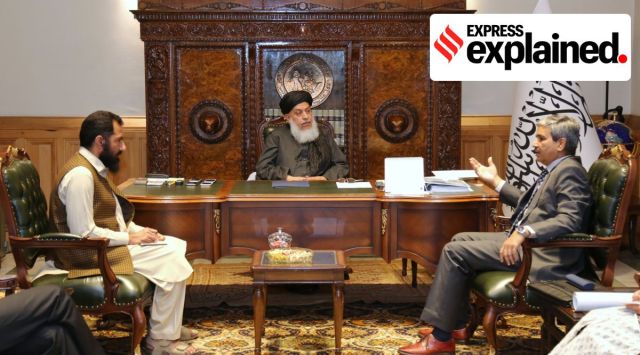- India
- International
Explained: Engaging with the Taliban
New Delhi sent a delegation to Kabul this week, the first time it has engaged officially with the Taliban regime. A look at India’s reluctance over the years, and how Pakistan’s shadow has influenced its stance.
 MEA Joint Secretary J P Singh (right) with Taliban’s acting Deputy Foreign Minister Sher Mohd Abbas Stanekzai (centre) in Kabul on Thursday'. (Twitter/Abdul Qahar Balkhi)
MEA Joint Secretary J P Singh (right) with Taliban’s acting Deputy Foreign Minister Sher Mohd Abbas Stanekzai (centre) in Kabul on Thursday'. (Twitter/Abdul Qahar Balkhi)When India sent an official delegation to Kabul earlier this week, it was the first time that New Delhi signalled that it wanted a formal engagement with the Taliban.
With this, it appears that the Indian foreign and security establishment is less divided about the need to engage formally with the Taliban and prevent getting marginalised in a country that New Delhi sees as vital to its strategic interests in the region, and where the people’s affection for India is legendary.
Although recognition of the Taliban government is not on the cards yet, Thursday’s visit may have paved the way for the reopening of the Indian embassy, albeit a downgraded one.
From 1996 to now, India’s journey from first opposition, then diffidence to engaging with the Taliban, to the resigned acceptance of its inevitability, is in no small measure a story of India’s problematic relationship with Pakistan.
In 1996, when the Taliban fought their way through warring mujahideen factions into Kabul for the first time, India, fearing a spillover on Kashmir insurgency (there was indeed some), backed the Northern Alliance with money and weapons. As the scholar Avinash Paliwal has pointed out (My Enemy’s Enemy: India in Afghanistan from the Soviet Union to the US Withdrawal), New Delhi did briefly contemplate opening contacts with the group but dropped the idea as the establishment was divided on reaching out to a group tied to Pakistan.

India bore the brunt of this nexus twice. During the 1999 hijacking of IC814, when the Pakistani hijackers took the plane to Kandahar, the then ruling Taliban acted as a support arm of the hijackers. Second, in 2008, the CIA traced the bombing of the Indian Embassy at Kabul to the Haqqani group, part of the Taliban and deeply embedded with the Pakistani security establishment. The bombing was reported to have been carried out at the orders of the ISI. Moreover, Lashkar -e-Taiba and Jaish-e-Mohammed were increasingly reported to be present in Afghanistan.
Reconsidering the Taliban
After 9/11, under the US umbrella, India invested money and energy into the rebuilding of Afghanistan. But by 2010, with increasing doubts about the US continuance, India was once again considering reaching out to the Taliban.
In the final months of UPA-2, Mullah Abdul Salam Zaeef , who was the Ambassador in Pakistan in the Taliban’s first regime, made a splash at a literary event in Goa. He had been invited as the author of the bestselling My Life with the Taliban. Then Home Minister P Chidambaram was in a photograph that also included him. Then in the opposition, the BJP trained its guns at the government for keeping company with an Islamist extremist.
Media reports then quoted government sources as saying it was not Zaeef’s first visit, and that keeping a door open to the Taliban was necessary. The reasons were the same as they are today: New Delhi did not want to be left out or marginalised in the Afghanistan of the future. After getting Osama bin Laden in Pakistan in 2011, the Obama Administration was getting ready to declare an end to the war, and the US and the Taliban had already made tentative contact towards talks.
But with Pakistan continuing to loom large – the Pakistan security establishment, which had a huge role in the birth of the Taliban, had given Mullah Omar and other Taliban leaders sanctuary in Quetta after the 2001 US invasion, and sustained them with money and weapons — New Delhi did not have the will to pursue the plan seriously.
Pakistan shadow
As talks between the Taliban and the Trump Administration took off, the Indian establishment decided to put its weight behind President Ashraf Ghani and the government of Afghanistan, which had been left out of the talks. When it became increasingly clear that far from collapsing, the talks might actually lead to Taliban rule or at least a set-up in Kabul with a significant Taliban presence, India flagged “concerns” about terrorism, even as it looked for a seat at the table in any of the several regional groups, and also for openings to the Taliban.
One view was to build relations with factions in the Taliban that were opposed to Pakistan, but there was little clarity on how strong such factionalism was, and if such factions had any influence. An Indian diplomat who had been approached by a Taliban leader once in a foreign capital said talking to the Taliban was “the same as talking to the ISI”.
It was evident that India had missed the bus. Pakistan had delivered the Taliban to the Trump Administration for talks. Russia was backing the Taliban fully as the future ruler of Afghanistan, seeing in this sweet revenge for its own defeat in Afghanistan by US-financed, Pakistan-trained mujahideen; Iran, also glad at America’s defeat at the hands of the Taliban, hosted a delegation of the Shia-persecuting group in Tehran. China leveraged its relationship with Pakistan to get a foot into Kabul.
Nine months after the Taliban took over Kabul, 15 countries have a diplomatic presence in the country. Pakistan, China and Russia never shut down; others, including the EU, have re-opened to facilitate to humanitarian assistance. The Taliban regime is not recognised by any country yet. When members of the Shanghai Co-operation Organisation’s anti-terror sub-group met in Delhi recently to discuss the situation in Afghanistan, host India was the only one without a diplomatic presence in Kabul.
Counter-intuitive timing
India’s cautious opening to the Taliban has come at a time when the group has made it clear it has not changed from its previous mediaevalism. Restrictions on women have increased, from not being allowed to attend school to curbs on free movement in public spaces and at work. A UN Taliban monitoring committee has reported that the Taliban continue to remain close to al-Qaeda, with a significant presence of its multinational fighting force in Afghanistan. The report has also flagged JeM and LeT training camps in Nangarhar and Kumar, close to the Pakistan border. India is the chair of the Taliban sanctions committee.
However, a view that has gained ground in the Indian establishment is that it is time to de-hyphenate Pakistan from the Taliban, especially as the Pakistan security establishment is finding the going tough with the Kabul regime.
The Pakistani Taliban (TTP), which has spread terror in Pakistan since it came into existence in 2007, has found sanctuary in Afghanistan, and it has taken several rounds of negotiations mediated by the Afghan Taliban for the Pakistan security establishment to arrive at a ceasefire with the TTP. There are other disagreements between the Kabul regime and Pakistan, including over Durand Line as the border between the two countries.
Another reason advanced for India’s change in policy is that the Taliban in power are more divided than they were as a fighting force, and that the situation may provide room for a layered political and diplomatic engagement with different actors. It has also helped that the Taliban have made no hostile statements on Kashmir since taking over in Kabul.
Newsletter | Click to get the day’s best explainers in your inbox
The ban on girls’ high-school education is reported to have brought out rifts in the open between hardliners led by supreme leader Mullah Haibatullah Akhundzada and others seen as pro-West Taliban, such as Sher Mohammad Abbas Stanekzai. In all this, the Haqqani are projecting themselves as the true moderates.
Gautam Mukhopadhaya, a former Indian Ambassador to Kabul, said the hardening of the regime, widening internal rifts, and the resistance against the Taliban getting more organised made for a “far from stable Taliban rule”.
As long as the move helps the Afghan people, facilitating humanitarian assistance through international organisations, and paving the way for access to consular services, Mukhopadhaya said it was a step in the right direction.
“It is a good move towards Afghan people, provided the [Afghan] opposition is being taken into confidence and is kept in touch with on a parallel track, and basic principles are not sacrificed for formal relations,” Mukhopadhaya said.
More Explained
EXPRESS OPINION
Apr 25: Latest News
- 01
- 02
- 03
- 04
- 05










































